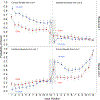Adult age differences in subjective context retrieval in dual-list free recall
- PMID: 36308518
- PMCID: PMC9992089
- DOI: 10.1080/09658211.2022.2139846
Adult age differences in subjective context retrieval in dual-list free recall
Abstract
Age-related episodic memory deficits imply that older and younger adults differentially retrieve and monitor contextual features that indicate the source of studied information. Such differences have been shown in subjective reports during recognition and cued recall as well as process estimates derived from computational models of free recall organisation. The present study extends the subject report method to free recall to characterise age differences in context retrieval and monitoring, and to test assumptions from a context-based computational model. Older and younger adults studied two lists of semantically related words and then recalled from only the first or second list. After each recall, participants indicated their subjective context retrieval using remember/know judgments. Compared to younger adults, older adults showed lower recall accuracy and subjective reports of context retrieval (i.e., remember judgments) that were less specific to correct recalls. These differences appeared after first-recall attempts. Recall functions conditioned on serial positions were more continual across correct recalls from target lists and intrusions from non-target lists for older than younger adults. Together with other analyses of context retrieval and monitoring reported here, these findings suggest that older adults retrieved context less distinctively across the recall period, leading to greater perceived similarity for temporally contiguous lists.
Keywords: Aging; context; episodic memory; free recall; recollection.
Figures








Similar articles
-
Age differences in the focus of retrieval: Evidence from dual-list free recall.Psychol Aging. 2015 Dec;30(4):768-80. doi: 10.1037/pag0000049. Epub 2015 Aug 31. Psychol Aging. 2015. PMID: 26322551 Free PMC article.
-
Age differences in collaborative memory: the role of retrieval manipulations.Mem Cognit. 2009 Oct;37(7):962-75. doi: 10.3758/MC.37.7.962. Mem Cognit. 2009. PMID: 19744936
-
Sensitivity of the hippocampus to objective but not subjective episodic memory judgments.Cogn Neurosci. 2022 Jul;13(3-4):165-170. doi: 10.1080/17588928.2022.2033713. Epub 2022 Feb 11. Cogn Neurosci. 2022. PMID: 35148666 Free PMC article.
-
Age-related differences in recall and recognition: a meta-analysis.Psychon Bull Rev. 2019 Oct;26(5):1529-1547. doi: 10.3758/s13423-019-01649-y. Psychon Bull Rev. 2019. PMID: 31396816 Review.
-
[Creation and normalisation of a verbal episodic memory task in elderly adults: "GERIA-12"].Rev Neurol (Paris). 2015 Dec;171(12):853-65. doi: 10.1016/j.neurol.2015.08.001. Epub 2015 Nov 10. Rev Neurol (Paris). 2015. PMID: 26563664 Review. French.
References
-
- Balota DA, Dolan PO, & Duchek JM (2000). Memory changes in healthy older adults. In Tulving E & Craik FIM (Eds.), The oxford handbook of memory (pp. 395–409). Oxford University Press.
-
- Bates D, Mächler M, Bolker B, & Walker S (2015). Fitting linear mixed-effects models using lme4. Journal of Statistical Software, 67(1). 10.18637/jss.v067.i01 - DOI
Publication types
MeSH terms
Grants and funding
LinkOut - more resources
Full Text Sources
Medical
